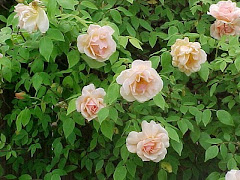Even though my garden plot is a fraction of the size I once cultivated--when there were teens to feed and pennies to pinch--I will still put hours into weeding, planting, cultivating,and watering (although this year, happily, Mother Nature has stepped up more responsibly, ending the pattern of drought and extreme heat that lasted for several years.) The asparagus bed, which yields its harvest in early Spring, requires only weeding and watering. The flowerbeds (planted heavily in my burst of enthusiasm after I retired) suffer from benign neglect--some weeding, some watering. The volunteer elderberries--sprouting in odd corners when I dispensed with the large thicket after the DHubby gave up making wine with the (messy) harvest--are bearing heavily despite complete neglect.
Last year, I cut the green heads of berries before they could ripen--such as they were, given the lack of rainfall. This year, ample water meant a bumper crop, and I couldn't bring myself to interfere. So... I picked the ripe heads of elderberries.
Once washed and allowed to air-dry, the heads go onto cookie sheets and into the freezer; after the berries are frozen solid overnight, one destems the berries; if this sounds tedious and time-consuming, that's because it is. A batch of elderberry jelly requires about 3 pounds of destemmed, crushed berries, from which juices must be extracted; that's another overnight process. And then you can cook up the jelly and put it up in jars.
The sine qua non of jelly-making: the right equipment.
A large, deep pot for boiling the juice, sugar, and other ingredients.
The pot on the left is fine for soup, for boiling pasta, for corn on the cob, but you want a deep, deep pot for jelly-making.
Then there is the long-handled spoon for stirring the jelly ingredients to a rolling boil. (The spoon is behind the ladle somewhat, but you can see how much longer it is than the copper serving ladle. Saves your hand from being parboiled!)
The wide funnel makes filling the jars neater and simpler.
The jars (with lids and rings) are filled while hot and sterile. Even with air-conditioning, making jelly is hot work.
It's rather easier to deal with the small amounts of vegetables I glean from the tiny garden. The biggest chore, aside from picking, is washing the produce. (I no longer freeze much of anything, even though I sadly acknowledge that frozen veggies from the store are not as tasty.)
Celebrity tomatoes; Roma green beans; jalapeno peppers. The arugula is the biggest pain when it comes to picking over and washing what I bring in from the garden plot.
The local farmers' market supplies what I don't grow--though not all vendors are organically-inclined. I bought my green tomatoes from a cooperative organic grower and made pickles. One batch will last us a couple of years; (they're delicious with bean soup for Wintertime suppers.)
When the figs come in, I will pick daily--twice daily when the figs are in full spate, so to speak. More washing and air-drying...and I do freeze figs in addition to those we eat and give away.
I don't usually dry many herbs, but I often go out and pick fresh basil, parsley, thyme, oregano, and 'Texas tarragon' (also sometimes labeled Mexican mint) as needed.
Summers are wonderful....as long as you're not hoping to lie around and relax!









No comments:
Post a Comment